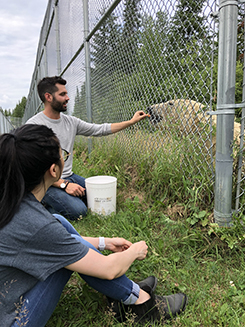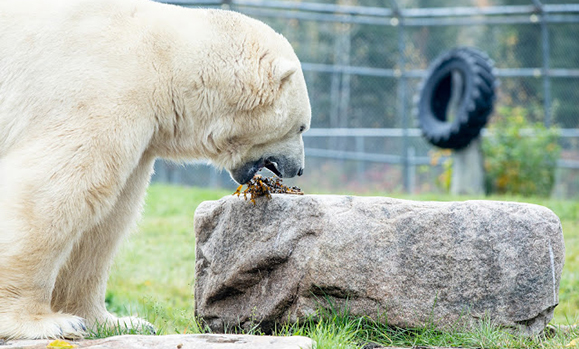Before heading out to do their fieldwork, Dr. Stephanie Collins, Jing Lu and their team would scan the horizon, get tips from local residents and check a whiteboard at the research station in Churchill, Manitoba, where they had settled in to do their research.
The subject of their study and surveillance?

Polar bears that were so numerous they could be seen strolling on the tundra while they waited for the water to freeze over in an area dubbed the "Capital of Polar Bears."
"It's a place where encountering polar bears is a surprisingly common occurrence. You could run into one almost anywhere," says Lu, a PhD student in Dal's Department of Animal Science and Aquaculture.
Shown right: Jing Lu and Dylan McCart with one of the polar bears at the Cochrane Polar Bear Habitat. (Stephanie Collins photo)
"It wasn’t unusual to find yourself enjoying a meal while a polar bear stared back at you through the window!"
Dr. Collins and Lu were in the region for a week in November 2018 to conduct a unique research project aimed at better understanding how climate change, captivity and food alterations affect the gut microbiome, diet, and overall health of this sentinel species.
On the hunt — for bear droppings
To do that, they needed to collect the fecal microbiome — microbes that digest food and are a good indicator of health — of captive and wild polar bears and compare them. That meant searching fields for bear poop as their guard stood watch.
They also needed to gather seaweed samples from the shore in areas frequented by bears to feed habitat-housed bears — named Inukshuk, Ganuk, Henry and Eddy — at the Cochrane Polar Bear Habitat. The animals were fed a higher protein mackerel-based diet and the seaweed to simulate the potential habitat and lifestyle changes polar bears may face due to climate change, particularly as the decline in Arctic Sea ice forces the bears to remain onshore without access to their traditional marine mammal-based diet.
They collaborated with colleagues at the bear habitat, the Churchill Northern Studies Centre, and Agriculture and Agrifood Canada for one of the first studies of its kind.
The team found that the captive polar bears, who had been on a long-term high-protein diet, exhibited a more diverse and distinct fecal microbiome than their wild counterparts, likely due to dietary and habitat shifts. Wild bears often rely on a diet of high-fat seals.

A bear named Inukshuk eating seaweed at the Cochrane Polar Bear Habitat. (Heather Brouwer photo)
Climate-spurred dietary shift
Shrinking Arctic Sea ice coverage and extended ice-free seasons reduce the area and window of time polar bears can spend on the ice platform. That is causing some populations to increase their land use to hunt for terrestrial animals, resulting in a switch from a fat-rich diet of seals to a low-fat, high protein diet for an extended period.
"Polar bears are among the most vulnerable species affected by shrinking sea ice and global warming. They rely on sea ice that forms in the winter under freezing temperatures for food, movement, and reproduction, consuming the majority of the food resources used to sustain them throughout the year during the winter months," says Lu.
Should they become landlocked due to a lack of sea ice and have to survive on terrestrial food sources, their diet and therefore gut microbiome will change.
"Our findings show that if they are able to adapt and survive, the polar bears we know now will be very different animals," says Dr. Collins.

